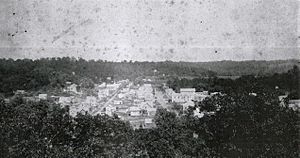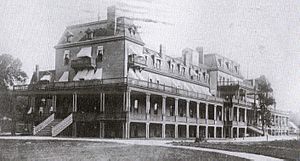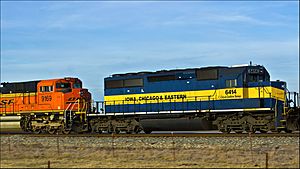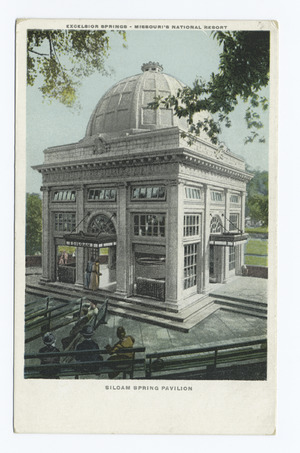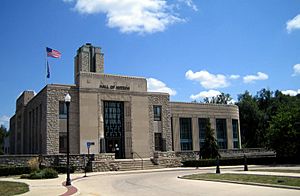Excelsior Springs, Missouri facts for kids
Quick facts for kids
Excelsior Springs, Missouri
|
|
|---|---|
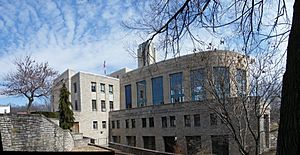
Hall of Waters (now City Hall)
|
|
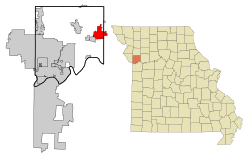
Location of Excelsior Springs, Missouri
|
|
| Country | United States |
| State | Missouri |
| Counties | Clay, Ray |
| Area | |
| • Total | 10.86 sq mi (28.13 km2) |
| • Land | 10.84 sq mi (28.08 km2) |
| • Water | 0.02 sq mi (0.05 km2) |
| Elevation | 866 ft (264 m) |
| Population
(2020)
|
|
| • Total | 10,553 |
| • Density | 973.25/sq mi (375.79/km2) |
| Time zone | UTC-6 (Central (CST)) |
| • Summer (DST) | UTC-5 (CDT) |
| ZIP code |
64024
|
| Area code(s) | 816 |
| FIPS code | 29-23086 |
| GNIS feature ID | 2394718 |
Excelsior Springs is a city in Missouri, a state in the United States. It is located in both Clay and Ray counties. This city is also part of the larger Kansas City metropolitan area. In 2020, about 10,553 people lived here. It is located about 30 miles (48 km) northeast of central Kansas City, Missouri.
Contents
Exploring Excelsior Springs' Location
Excelsior Springs is found along the East Fork Fishing River. The city covers a total area of about 10.45 square miles (27.07 km2). Most of this area is land, with only a small part being water.
Who Lives in Excelsior Springs?
The city has grown quite a bit over the years. Here's how the population has changed:
| Historical population | |||
|---|---|---|---|
| Census | Pop. | %± | |
| 1890 | 2,034 | — | |
| 1900 | 1,881 | −7.5% | |
| 1910 | 3,900 | 107.3% | |
| 1920 | 4,165 | 6.8% | |
| 1930 | 4,565 | 9.6% | |
| 1940 | 4,864 | 6.5% | |
| 1950 | 5,888 | 21.1% | |
| 1960 | 6,473 | 9.9% | |
| 1970 | 9,411 | 45.4% | |
| 1980 | 10,424 | 10.8% | |
| 1990 | 10,354 | −0.7% | |
| 2000 | 10,847 | 4.8% | |
| 2010 | 11,084 | 2.2% | |
| 2020 | 10,553 | −4.8% | |
| U.S. Decennial Census | |||
Excelsior Springs in 2020
In 2020, the 2020 United States census counted 10,553 people in Excelsior Springs. There were 4,083 households and 2,784 families. Most residents, about 88.5%, were white. About 1.7% were black. Other groups included Native American, Asian, and people of two or more races. About 5% of the population was Hispanic or Latino.
About 26.3% of households had children under 18. Many households, 51.4%, were married couples. The average household had 2.7 people. The average family had 3.3 people.
The median age in the city was 35.8 years. About 25.9% of the population was under 18. About 17.6% were 65 or older.
Excelsior Springs in 2010
The census in 2010 showed 11,084 people living in the city. There were 4,278 households. Most people, 92.6%, were White. About 2.8% were African American. Other groups included Native American and Asian people. About 3.3% of the population was Hispanic or Latino.
About 34% of households had children under 18. The average household size was 2.46 people. The average family size was 2.99 people.
The median age was 36.6 years. About 24.9% of residents were under 18. About 14.9% were 65 or older.
A Look at Excelsior Springs' Past
An important event happened here in 1834. A group of about 200 Mormon believers, called Zion's Camp, were marching. They were trying to help their friends in Jackson County. They met a large, angry crowd of over 300 people. A big fight was about to start near the Fishing River. But then, a huge thunderstorm suddenly appeared. The storm made the angry crowd run away. Zion's Camp was able to continue safely. You can find historical markers about this event nearby.
How the Town Began: 1880s to 1910s
Excelsior Springs was founded because of special natural spring water. This water came out of the ground in 1880. A Black farmer named Travis Mellion accidentally found it. His daughter, Opal, was very sick with a skin disease called scrofula (a type of tuberculosis). Campers nearby told him about the spring water. He brought the water to his daughter. In a few weeks, she got much better and eventually recovered. Another farmer, Frederick Kugler, also used the water for his rheumatism and a old Civil War wound. He also got better.
Rev. John Van Buren Flack heard about the water in 1880. He traveled to the spring, which was on land owned by Anthony W. Wyman. After checking the water, Flack told Wyman to map out the land and advertise the water's healing powers. Flack built a home on 40 acres (16 ha) of Wyman's land. He also opened the town's first store and church. The spring was named Excelsior, after a famous poem by Henry Wadsworth Longfellow. Later, it was called Siloam.
On August 17, 1880, Flack and Wyman officially started the community of Excelsior. The post office didn't allow that name because another town in Missouri already used it. So, the town was first named Vigniti. In 1882, it was finally renamed Excelsior Springs.
Within one year, almost 200 homes were built. Many people came to the area because of the successful springs. They camped in tents or wagons. On February 7, 1881, the town became a village. On July 12, 1881, it became a city. This brought hotels, boarding houses, churches, schools, and even an opera house.
In 1881, Captain J.L. Farris found a second mineral spring, first called Empire Spring, then Regent Spring. A third, Relief Spring, was found in the Fishing River. Many more springs were soon discovered. The most important ones were Relief, Superior, and Saratoga springs. A pump was put at Siloam Spring. Steps were built from Broadway Street to the city's first hotel, the Excelsior. A small wooden bridge was built over the Fishing River. This led to a quiet area where visitors could relax. Excelsior Springs grew faster than any other city in Missouri in its first year.
The city's first hotel, the Excelsior, was very large for its time. It opened on March 1, 1881. It quickly filled with visitors from cities like St. Louis and Kansas City. These visitors came to try the medicinal waters. The Excelsior Hotel was the main hotel until the first Elms Hotel opened in 1888.
In 1887, the Chicago, Milwaukee and St. Paul railroad built a train line to Excelsior Springs. This brought even more visitors. A company called Relief Springs and Land Company was formed. They bought 1,000 acres (400 ha) of land around the city to advertise it. The famous Elms Hotel began construction. A large theater called the Music Hall was also built. It could hold 1,320 people. An amusement park was built, but it later became a place to bottle water. A bigger building with benches was put at Siloam Spring. Visitors could drink the water there. The water had a lot of iron, which would stain their cups. The city worked with the railroad to advertise itself as a resort across the country. In 1897, the city got its first telephone service.
More special waters were found. A famous professor, W.P. Mason, studied them. He found that the Siloam and Regent spring waters had special minerals like iron and manganese. This was very rare. Only four other springs in Europe had this mix. Excelsior Springs had the only two known in the United States. Because it had 20 different mineral springs, Excelsior Springs became known for having the world's best collection of mineral waters.
Other minerals found in the springs included Sulphur, Soda-Bicarbonate, and Calcic-Bicarbonate (also called Lithia). Most mineral water resorts at the time only offered baths. But Excelsior Springs had four different types of treatments. The city gained international attention in 1893. At the Chicago's World Fair, it won awards for its iron-manganese water and a drink called Soterian ginger ale.
In October 1893, more train service started. This connected the city to the Wabash Railroad. Fires later destroyed the Excelsior Hotel and the Elms Hotel. New plans were made to rebuild the Elms Hotel. The "Second" Elms Hotel was finished in 1908, but it also burned down. The third and current Elms Hotel was built in 1912. Other hotels like Wholf's Tavern (later Royal Hotel) and Snapp Hotel (later Oaks Hotel) were also built. By 1909, the city had 14 modern hotels and about 200 boarding houses.
A park system was approved, costing about $200,000 in 1909. This led to the Excelsior Springs Golf Course. Many buildings were also built, like the Masonic Hall and an auditorium. In January 1912, a train service to Kansas City started running every hour. Better public services and new highways helped Excelsior Springs grow even more.
From the 1930s to Today
The Great Depression (a time of great economic hardship) did not hurt Excelsior Springs as much as other towns. This was because it was a popular health resort. Between 1930 and 1940, the town gained 370 citizens. Its population reached 4,800, while most other small towns were losing people.
The current city hall, called the Hall of Waters, was built between 1936 and 1938. It was designed by architects Keene & Simpson. It stands above the Siloam and Sulpho-Saline Springs. On May 27, 1936, many people gathered for the laying of the cornerstone. CBS broadcast the event to 62 radio stations across the country. Famous people like actress Evalyn Knapp, artist Thomas Hart Benton, and author Homer Croy were there.
In 1937, the building was partly finished. The water bar on the lower level opened. It offered mineral waters to visitors. Later, a mineral water pool and special hydrotherapy (water treatment) departments opened. A two-story hall was also built where minerals were available at fountains. The first floor had the women's bath area, a sunroom, and the main office for the springs.
The swimming pool was large enough for championship swim meets. In the south part of the building, there were special hydrotherapy departments. These were used to study the medicinal value of the waters. The bottling area was on the east side of the north part. It shipped five types of bottled mineral water all over the world.
On Election Day in 1948, Harry S. Truman stayed at the Elms Hotel. It looked like he was losing his re-election to Thomas E. Dewey. But early the next morning, his helpers woke him up. They told him he had actually won the election! He quickly left for Kansas City. Later, he was famously photographed holding a newspaper that mistakenly said "Dewey Defeats Truman".
In 1955, Flooding caused problems. A dike was built to protect the Hall of Waters from the nearby Fishing River. This removed some stone paths at Siloam Park. There were more floods in the late 1960s, 1993, and 2015.
The late 1950s and early 1960s were tough for the city. The popularity of resort spas declined a lot. By 1967, the bottling business was losing money. The city decided to move on from its mineral water history. However, 2008, Excelsior Springs has allowed a company to bottle and sell the historic mineral water again.
Several places in Excelsior Springs are on the National Register of Historic Places. These include the Elms Hotel, Hall of Waters, the Colonial Hotel, The Elms Historic District, Excelsior Springs Hall of Waters Commercial East Historic District, Excelsior Springs Hall of Waters Commercial West Historic District, First Methodist Church, Ligon Apartments, Watkins Mill, and Wyman School.
What Excelsior Springs Offers Today
Excelsior Springs has a renewed historic downtown area. It used to have many empty buildings and antique stores. Now, you can find a quilt shop, an art store, and several small restaurants. The old antique stores are still there too. The city has two theaters: The Paradise Playhouse, which has professional shows, and The Slightly Off-Broadway Theater, which has local community plays.
Learning in Excelsior Springs
The Excelsior Springs School District #40 runs several schools. There are three elementary schools, one middle school, Excelsior Springs Tech. High School, Excelsior Springs High School, and Excelsior Springs Career Center.
The city's public library is part of the Mid-Continent Public Library system.
Famous People from Excelsior Springs
Many notable people have connections to Excelsior Springs:
- Hilary A. Bush (1905–1966) was a politician. He was the Lieutenant Governor of Missouri from 1961 to 1965.
- James Benton Grant (1848–1911) was the 3rd Governor of Colorado. He died in Excelsior Springs.
- Brenda Joyce (1917–2009) was an actress. She was born in Excelsior Springs and played "Jane" in five Tarzan movies.
- Donald Judd (1928–1994) was a visual artist. He was born in Excelsior Springs.
- Shaun Marcum (born 1981) is a Major League Baseball pitcher. He grew up in Excelsior Springs and played high school sports.
- Tim Spehr (born 1966) was a catcher for the Montreal Expos and Kansas City Royals.
- Lyle Waggoner (1935–2020) was an actor and sculptor. He was raised in Excelsior Springs and was on Wonder Woman and The Carol Burnett Show.
- Gregg Williams (born 1958) is a football coach. He was born in Excelsior Springs and played quarterback in high school.
Images for kids
See also
 In Spanish: Excelsior Springs (Misuri) para niños
In Spanish: Excelsior Springs (Misuri) para niños


